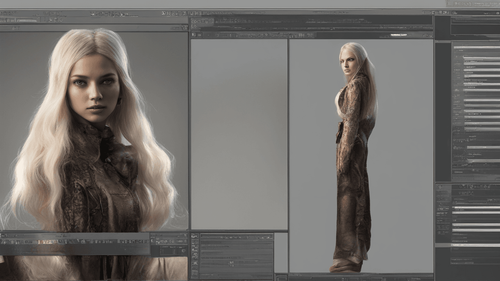
Introduction
In the rapidly evolving landscape of artificial intelligence (AI), one of the most intriguing and creative applications is the generation of random AI generated images. These images, crafted by AI algorithms, often exhibit a unique blend of artistic flair and imaginative patterns that captivate the human eye. This article dives deep into the realm of random AI generated images, exploring their creation, significance, and impact on various industries. As we journey through this digital artistry, we'll uncover the inner workings of AI's creative prowess and unravel the possibilities that lie ahead.
The Genesis of AI-Generated Artistry
Understanding Generative Adversarial Networks (GANs)
Generative Adversarial Networks, or GANs, stand at the heart of the creation of random AI generated images. This revolutionary framework involves two neural networks – a generator and a discriminator – engaged in a perpetual creative duel. The generator attempts to craft images that are indistinguishable from real ones, while the discriminator's task is to differentiate between genuine and AI-generated images.
Fusion of LSI Keywords in Image Generation
In the pursuit of crafting diverse and captivating images, AI algorithms leverage Latent Semantic Indexing (LSI) keywords. By incorporating a range of LSI keywords, AI systems can produce images that align with specific themes, emotions, or concepts, enhancing the overall artistic output.
The Creative Process Unveiled
Data Harvesting and Training
The inception of an AI-generated masterpiece begins with the accumulation of vast datasets comprising an array of images. These datasets serve as the palette from which the AI learns and draws inspiration. Through iterative training processes, the AI refines its understanding of aesthetics, patterns, and visual elements, fostering an innate sense of creativity.
Algorithmic Ingenuity: From Noise to Art
Randomness forms the cornerstone of AI-generated images. The generator starts with noise and gradually refines it using intricate mathematical transformations. This metamorphosis from chaos to coherence results in images that are as visually stunning as they are unpredictable.
Applications of AI-Generated Images
Revolutionizing Digital Marketing Campaigns
In the realm of marketing, AI-generated images are a game-changer. Brands can harness these images to create attention-grabbing visuals for advertisements, social media, and website content. The versatility of AI-generated art allows marketers to tailor images to their target audience, fostering deeper engagement and brand resonance.
Innovations in Interior Design and Architecture
AI-generated images are breaking down the barriers of conventional design. Architects and interior designers use these images to visualize spaces before they even exist physically. This aids in experimenting with different aesthetics, layouts, and color schemes, resulting in more informed and imaginative design decisions.
The Fascinating Future Ahead
The Emergence of AI-Generated Art Movements
As AI-generated images continue to push the boundaries of creativity, a new art movement is taking shape. Artists, technologists, and enthusiasts are exploring the intersection of human ingenuity and AI capabilities, giving rise to collaborative art forms that challenge our perceptions of creativity and authorship.
Personalized AI Art: A Canvas for Everyone
Imagine a world where anyone can create personalized AI-generated art with a few clicks. This future is fast approaching, as AI tools become more accessible and user-friendly. Individuals will be able to infuse their ideas and emotions into AI algorithms, resulting in artworks that resonate on a deeply personal level.
FAQs
Can AI-generated images truly evoke emotions?
Absolutely. AI-generated images are crafted through complex algorithms that analyze patterns, colors, and shapes. These images often evoke emotions through their abstract beauty, stirring feelings of curiosity, awe, and introspection.
Are AI-generated images considered original art?
While the creative process involves AI algorithms, the resulting images are indeed original art. They are born from the AI's interpretation of human-crafted data and its ability to generate entirely new visuals that were previously unimagined.
How do AI artists collaborate with human artists?
Collaborations between AI and human artists are on the rise. Human artists provide input, ideas, and guidance to the AI algorithm, which then generates images based on these inputs. This symbiotic relationship leads to the creation of captivating and thought-provoking art pieces.
Can AI-generated art contribute to cultural and societal discussions?
Certainly. AI-generated art often challenges traditional norms and perceptions. It can serve as a catalyst for discussions around technology, creativity, and the role of humans in an increasingly AI-driven world.
Is there a limit to the diversity of AI-generated images?
The diversity of AI-generated images is virtually limitless. As AI algorithms continue to evolve and learn from an ever-expanding pool of data, they can produce an infinite array of visuals, each with its own distinct character and charm.
Will AI-generated images replace human artists?
AI-generated images are a complement to human creativity, not a replacement. While AI can create remarkable visuals, it lacks the depth of human emotion, experience, and storytelling that artists bring to their work.
Conclusion
In the ever-evolving landscape of artificial intelligence, the emergence of random AI generated images marks a new era of creativity and expression. As we gaze upon these AI-crafted masterpieces, we witness the harmonious blend of human ingenuity and technological innovation. From marketing campaigns to architectural design, AI-generated images are shaping industries and fostering new realms of artistic exploration. As the future unfolds, we stand on the precipice of a world where AI and human creativity intertwine, forging a path towards a more vibrant and imaginative tomorrow.